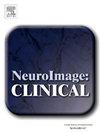Efficacy of cognitive rehabilitation in cognition and brain networks: A randomised clinical trial in patients with multiple sclerosis
IF 3.6
2区 医学
Q2 NEUROIMAGING
引用次数: 0
Abstract
This study evaluated the efficacy of the computerised Guttmann, NeuroPersonalTrainer® (GNPT) cognitive rehabilitation (CR) and characterised the induced changes in cerebral networks in patients with multiple sclerosis (MS). This multicentre, double-blind, randomised clinical trial compared upward intensity training (active treatment) to low-intensity static training (static treatment). Cognition was assessed using the Brief Repeatable battery before and after 12 weeks of training and at 10-months follow-up, and patients were classified as having a mild or severe cognitive impairment (CI). Brain MRI pre- and post-CR were analysed using an advanced tractography algorithm, based on multishell diffusion MRI, to obtain node-based graph metrics (local efficiency and strength) from microscopic fractional anisotropy. Seventy MS patients completed the study (age 48.9 ± 8.8, disease duration 16.8 ± 9.0 years); active treatment: 36, static treatment: 34. Verbal memory improved significantly post-CR in both groups (55 % active; 34 % static treatment), accompanied by increases in local efficiency and strength in multimodal regions. At follow-up, verbal memory declined in both groups but remained above the pre-CR assessment (−25 % and −17 %, respectively). Patients with severe-CI (n = 36) showed improvement only with active treatment, while those with mild-CI (n = 34) improved regardless of intensity treatment. Network changes were more pronounced in patients in active treatment and in those with severe-CI. Quality of life did not change at post-CR, and cognitive improvement was influenced by cognitive reserve (p = 0.011). In MS, GNPT temporarily improves verbal memory and increases network connectivity, reinforcing the CR as a valuable tool for enhancing cognitive skills and promoting neuronal plasticity.
认知康复对认知和脑网络的疗效:多发性硬化症患者的随机临床试验
本研究评估了计算机化Guttmann, NeuroPersonalTrainer®(GNPT)认知康复(CR)的疗效,并描述了多发性硬化症(MS)患者大脑网络的诱导变化。这项多中心、双盲、随机临床试验比较了高强度训练(积极治疗)和低强度静态训练(静态治疗)。在12周训练前后和10个月的随访中,使用Brief Repeatable电池评估认知能力,并将患者分为轻度或重度认知障碍(CI)。使用基于多壳扩散MRI的先进神经束成像算法分析脑MRI前后cr,从微观分数各向异性中获得基于节点的图度量(局部效率和强度)。70例MS患者完成研究(年龄48.9±8.8岁,病程16.8±9.0年);主动处理:36,静态处理:34。两组患者的言语记忆在cr后均有显著改善(55%活跃;34%静态处理),同时在多模式区域增加局部效率和强度。在随访中,两组的言语记忆均有所下降,但仍高于cr前评估(分别为- 25%和- 17%)。重度ci患者(n = 36)仅在积极治疗下才有改善,而轻度ci患者(n = 34)无论治疗强度如何均有改善。网络变化在积极治疗的患者和严重ci患者中更为明显。cr后患者的生活质量没有变化,认知储备对认知改善有影响(p = 0.011)。在MS中,GNPT暂时改善了言语记忆和增加了网络连接,加强了CR作为提高认知技能和促进神经元可塑性的有价值的工具。
本文章由计算机程序翻译,如有差异,请以英文原文为准。
求助全文
约1分钟内获得全文
求助全文
来源期刊

Neuroimage-Clinical
NEUROIMAGING-
CiteScore
7.50
自引率
4.80%
发文量
368
审稿时长
52 days
期刊介绍:
NeuroImage: Clinical, a journal of diseases, disorders and syndromes involving the Nervous System, provides a vehicle for communicating important advances in the study of abnormal structure-function relationships of the human nervous system based on imaging.
The focus of NeuroImage: Clinical is on defining changes to the brain associated with primary neurologic and psychiatric diseases and disorders of the nervous system as well as behavioral syndromes and developmental conditions. The main criterion for judging papers is the extent of scientific advancement in the understanding of the pathophysiologic mechanisms of diseases and disorders, in identification of functional models that link clinical signs and symptoms with brain function and in the creation of image based tools applicable to a broad range of clinical needs including diagnosis, monitoring and tracking of illness, predicting therapeutic response and development of new treatments. Papers dealing with structure and function in animal models will also be considered if they reveal mechanisms that can be readily translated to human conditions.
 求助内容:
求助内容: 应助结果提醒方式:
应助结果提醒方式:


